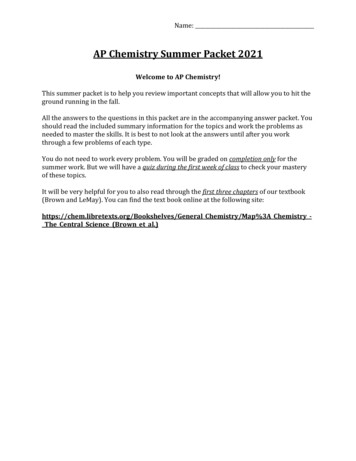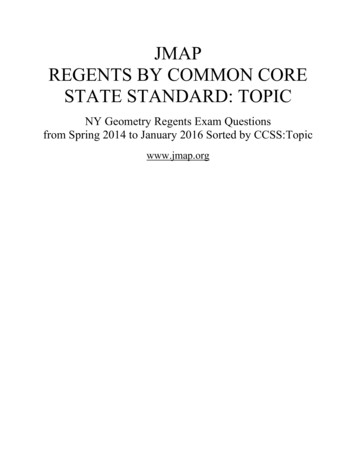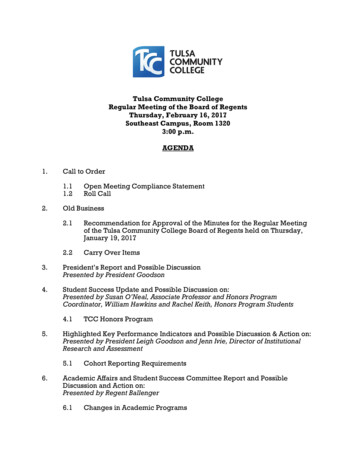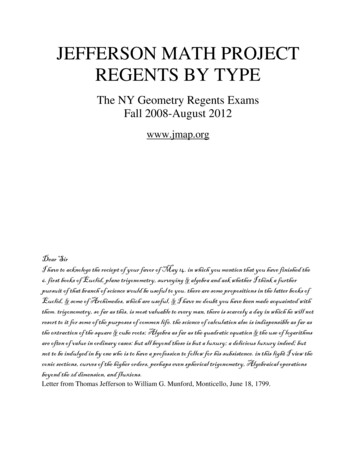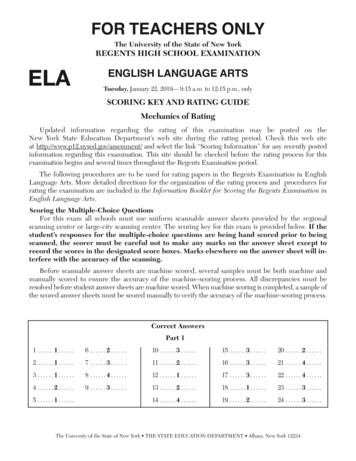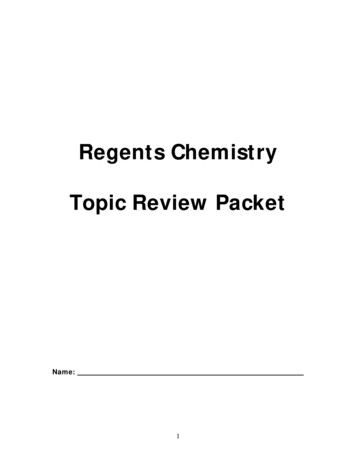
Transcription
Regents ChemistryTopic Review PacketName:1
Table of ContentsTopic 1: Matter, Its Properties & ChangesOutline 3Practice Questions . 5Topic 2: Atomic ConceptsOutline 8Practice Questions . 10Topic 3: Periodic TableOutline . 17Practice Questions . 19Topic 4: Formulas & Names, Equations, Moles,Molar Mass, & Types of ReactionsOutline . 25Practice Questions . . 26Topic 5: BondingOutline . 33Practice Questions . . 35Topic 6 Overview . . . 42Topic 6A: Heat & TemperatureOutline . 43Practice Questions . 45Topic 6B: Kinetics & EquilibriumOutline . 50Practice Questions . 51Topic 7: Water & SolutionsOutline . . 55Practice Questions . . 56Topic 8: Acids & BasesOutline . 61Practice Questions . . 62Topic 9: Organic ChemistryOutline . 66Practice Questions . . 67Topic 10: Phases & GasesOutline . 71Practice Questions . 72Topic 11: Electrochemistry (Oxidation-Reduction)Outline . 75Practice Questions . 76Answer Key 832
Topic 1: Matter, Its Properties and Changes Outline1. Matter is classified as a pure substance or a mixture of substances.A pure substance (element or compound) has a constant compositionand constant properties throughout a given sample, and from sampleto sample. You can use particle models/diagrams to differentiate among elements,compounds, and mixtures.2. The proportions of components in a mixture can be varied. Eachcomponent in a mixture retains its original properties. Differences inproperties such as density, particle size, molecular polarity, boilingpoint and freezing point, and solubility permit physical separation ofthe components of the mixture. Methods of separating mixtures include evaporation, filtration, distillation,and chromatography. Mixtures can be homogeneous or heterogeneous. Solutions are alwayshomogeneous. Heterogeneous mixtures are things like soil, fruit salad,where the composition is NOT uniform throughout the mixture.3. The structure and arrangement of particles and their interactionsdetermine the physical state of a substance at a given temperature andpressure. Know the states (phases) of the elements at STP; Br and Hg are the only2 liquids, the noble gases as well as N, O, F, H, and Cl are gases, the restare solids Know the 7 elements that are diatomic in their natural states; “7-Up” or“HOFBrINCl”. Draw particle models of solids, liquids, and gases.4. A physical change results in the rearrangement of existing particlesin a substance; no new types of particles result from this type ofchange. A chemical change results in the formation of differentparticles with changed properties. Distinguish between chemical and physical changes based on whethernew substances form or not.3
5. Properties can be physical or chemical. Physical properties describethose characteristics that can be observed with the senses ormeasured. Chemical properties describe how the substance interactswith other substances. Distinguish between chemical and physical properties. One of the more useful properties is density. The density equation is onTable T; D m/V. Some common properties of the elements are found on Table S, such asmelting and boiling points.4
Matter – Cut from Jan 2007 – Jan 2008 Exams1. A sample composed only of atoms having thesame atomic number is classified as(1) a compound(3) an element(2) a solution(4) an isomer8. Which element is a solid at STP and a goodconductor of electricity?(1) iodine(3) nickel(2) mercury(4) sulfur2. A dilute, aqueous potassium nitrate solution isbest classified as a(1) homogeneous compound(2) homogeneous mixture(3) heterogeneous compound(4) heterogeneous mixture9. The table below shows mass and volume datafor four samples of substances at 298 K and1 atmosphere.3. At which Celsius temperature does lead changefrom a solid to a liquid?(1) 874 C(3) 328 C(2) 601 C(4) 0 C4. Which statement describes a chemical property ofhydrogen gas?(1) Hydrogen gas burns in air.(2) Hydrogen gas is colorless.(3) Hydrogen gas has a density of 0.000 09 g/cm3 atSTP.(4) Hydrogen gas has a boiling point of 20. K atstandard pressure.Which two samples could consist of the samesubstance?(1) A and B(3) B and C(2) A and C(4) C and D10. Bronze contains 90 to 95 percent copper and 5 to10 percent tin. Because these percentages can vary,bronze is classified as(1) a compound(3) a mixture(2) an element (4) a substance5. Which element has the greatest density at STP?(1) calcium(3) chlorine(2) carbon(4) copper11. At STP, which list of elements contains a solid, aliquid, and a gas?(1) Hf, Hg, He (3) Ba, Br2, B(2) Cr, Cl2, C(4) Se, Sn, Sr6. Which statement describes a chemical property ofthe element magnesium?(1) Magnesium is malleable.(2) Magnesium conducts electricity.(3) Magnesium reacts with an acid.(4) Magnesium has a high boiling point.12. A 10.0-gram sample of which element has thesmallest volume at STP?(1) aluminum(3) titanium(2) magnesium(4) zinc7. Matter that is composed of two or more differentelements chemically combined in a fixedproportion is classified as(1) a compound(3) a mixture(2) an isotope (4) a solution13. At room temperature, a mixture of sand andwater can be separated by(1) ionization(3) filtration(2) combustion(4) sublimation5
14. Which particle diagram represents a sample of one compound, only?15. A 1.00-mole sample of neon gas occupies a volume of 24.4 liters at 298 K and 101.3 kilopascals. Calculate thedensity of this sample. Your response must include both a correct numerical setup and the calculated result.Base your answers to questions 16 through 18 on the information below.In an investigation, a dripless wax candle is massed and then lighted. As the candle burns, a small amount ofliquid wax forms near the flame. After 10 minutes, the candle’s flame is extinguished and the candle is allowed tocool. The cooled candle is massed.16. Identify one physical change that takes place in this investigation.17. State one observation that indicates a chemical change has occurred in this investigation. 18. Draw a particle diagram showing the change from solid wax to liquid wax. Use “ ” for particles of wax.Draw separate diagrams for the liquid and the solid states.6
Base your answers to questions 19 through 21 on the particle diagrams below, which show atoms and/ ormolecules in three different samples of matter at STP.19. Which sample represents a pure substance?20. When two atoms of y react with one atom of z, a compound forms. Using the number of atoms shownin sample 2, what is the maximum number of molecules of this compound that can be formed?21. Explain why xx does not represent a compound.7
Topic 2: Atomic Concepts Outline1. The modern model of the atom has evolved over a long period of time through thework of many scientists. Dalton’s Model: Elements are made of atoms Atoms of an element are the same. Compounds are formed from combinations of atoms. Rutherford Experiment Bombarded gold foil with alpha particles. Showed atomswere mostly empty space with small, dense positivelycharged nucleus. Bohr Model Small, dense, positively charged nucleus surrounded by electrons in circular orbits. Wave-Mechanical Model (Modern Atomic Theory) Small, dense, nucleus positively charged nucleussurrounded by electrons moving in “electron cloud”. “Orbitals” are areas where an electron with a certain amount of energy is most likelyto be found.2. Each atom is made of a positively charged nucleus with one or more orbiting,negatively charged electrons.3. Protons and neutrons are found in the nucleus. The number of protons in an atom’s nucleus gives the nucleus a positive charge. Li hasa “nuclear charge” of 3, since it has 3 protons.4. Protons have a positive charge, neutrons no charge, and electrons a negativecharge.5. The number of protons in an atom equals the number of electrons. The positive charges of the protons are cancelled by the negative charges of the electrons,so overall an atom has a neutral charge.6. The mass of a proton is 1 amu. The mass of a neutron is 1 amu. The mass of anelectron is almost 0 amu. The mass of an atom is contained in its nucleus. The atomic mass of an atom is equal to the total number of protons and neutrons.7. Each electron in an atom has its own distinct amount of energy. When all electrons are at their lowest possible energy, it is called the “ground state.” Electrons fill in energy levels and orbitals starting with the one that requires the least energyand progressively move to those levels and orbitals that require increasing amounts ofenergy.8
8. When the electron gains a specific amount of energy, it moves to a higher orbitaland is in the “excited state”. You can recognize an excited state electron configuration. If the configuration doesnot match that on the Periodic Table for that number of electrons, then it is anexcited state.9. When an electron returns from a higher energy state to a lower energy state, itemits a specific amount of energy usually in the form of light. This can be used toidentify an element (bright line spectrum). The instrument used to see the bright line spectrum is called a spectroscope.10. The outermost electrons are called valence electrons. These affect the chemicalproperties of the element. Atoms with a filled valence level are stable (noble gases). Most elements can have up to 8 electrons in their valence level. The exceptions are H andHe, which can have only 2 valence electrons. Atoms form bonds in order to fill their valence levels. You can use Lewis structures to show the configuration of the valence electrons.11. Atoms of the same element all contain the same number of protons. Changing the number of protons changes the atom into a different element. The atomic number is the number of protons in an atom of an element.12. Isotopes are atoms with equal numbers of protons but different numbers ofneutrons. Isotopes of an element have the same atomic number (protons only), but different atomicmasses (protons neutrons).13. The average atomic mass of an element is the weighted average of its naturallyoccurring isotopes. You need to know how to do the calculation of “weighted atomic mass” given isotopemasses and percent abundances.14. When an atom gains an electron, it becomes a negative ion and its radiusincreases.15. When an atom loses an electron, it becomes a positive ion and its radiusdecreases.16. Electronegativity indicates how strongly an atom of an element attractselectrons in a chemical bond. These values are based on an arbitrary scale. Fluorine has the highest electronegativity of all elements (4.00).9
Atomic Structure – Practice Questions1. Experiments performed to reveal the structure of atoms led scientists to conclude that anatom’s(1) positive charge is evenly distributed throughout its volume(2) negative charge is mainly concentrated in its nucleus(3) mass is evenly distributed throughout its volume(4) volume is mainly unoccupied2. The modern model of the atom shows that electrons are(1) orbiting the nucleus in fixed paths(2) found in regions called orbitals(3) combined with neutrons in the nucleus(4) located in a solid sphere covering the nucleus3. An experiment in which alpha particles were used to bombard thin sheets of gold foil ledto the conclusion that an atom is composed mostly of(1) empty space and has a small, negatively charged nucleus(2) empty space and has a small, positively charged nucleus(3) a large, dense, positively charged nucleus(4) a large, dense, negatively charged nucleus4. What is the atomic number of an element that has six protons and eight neutrons?(1) 6(2) 2(3) 8(4) 145. An atom of fluorine has a mass of 19 atomic mass units. The total number of protonsand neutrons in its nucleus is(1) 9(2) 10(3) 19(4) 286. What is the total number of protons contained in the nucleus of a carbon-14 atom?(1) 6(2) 8(3) 12(4) 147. What is the nuclear charge of an iron atom?(1) 26(2) 30(3) 56(4) 828. Which of these elements has an atom with the most stable outer electron configuration?(1) Ne(2) Cl(3) Ca(4) Na9. How many electrons are in the outermost principal energy level of an atom of carbon inthe ground state?(1) 6(2) 2(3) 3(4) 410. Which electron configuration is correct for a sodium ion?(1) 2-7(2) 2-8(3) 2-8-1(4) 2-8-211. What is the electron configuration of a sulfur atom in the ground state?(1) 2-4(2) 2-6(3) 2-8-4(4) 2-8-610
12. The nucleus of which atom contains 48 neutrons?(1) 1632 S(2) 48(3) 3785 Rb22Ti(4)11248Cd13. The number of neutrons in the nucleus of an atom can be determined by(1) adding the atomic number to the mass number(2) subtracting the atomic number from the mass number(3) adding the mass number to the atomic mass(4) subtracting the mass number from the atomic number14. When an atom loses an electron, the atom becomes an ion that is(1) positively charged and gains a small amount of mass(2) positively charged and loses a small amount of mass(3) negatively charged and gains a small amount of mass(4) negatively charged and loses a small amount of mass15. In which pair of elements do the nuclei of the atoms contain the same number ofneutrons?23(3) 11(1) 37 Li and 49 BeNa and 1224 Mg(2)147N and168O(4)3216S and3517Cl16. The characteristic spectral lines of elements are caused when electrons in an excitedatom move from(1) lower to higher energy levels, releasing energy(2) lower to higher energy levels, absorbing energy(3) higher to lower energy levels, releasing energy(4) higher to lower energy levels, absorbing energy17. Which Lewis electron-dot structure is drawn correctly for the atom it represents?18. When a lithium atom forms a Li ion, the lithium atom(1) gains a proton(3) loses an electron(2) loses a proton(4) gains an electron19. What is the total number of electrons in the valence shell of an atom of aluminum in theground state?(1) 8(2) 2(3) 3(4) 1020. An electron in an atom moves from the ground state to an excited state when the energyof the electron(1) increases(2) decreases(3) remains the same11
21. During a flame test, ions of a specific metal are heated in the flame of a gas burner. Acharacteristic color of light is emitted by these ions in the flame when the electrons(1) emit energy as they move to higher energy levels(2) emit energy as they return to lower energy levels(3) gain energy as they move to higher energy levels(4) gain energy as they return to lower energy levels22. What is the total number of electrons in a Cu ion?(1) 36(2) 29(3) 30(4) 28Base your answers to questions 23 and 24 on the information and the bright-line spectrarepresented below.Many advertising signs depend on the production of light emissions from gas-filled glasstubes that are subjected to a high-voltage source. When light emissions are passedthrough a spectroscope, bright-line spectra are produced.23. Identify the two gases in the unknown mixture.24. Explain the production of an emission spectrum in terms of the energy states of an electron.12
Atomic Concepts Review – Cut from Jan 2007 – Jan 2008 Exams6. Which isotopic notation identifies a metalloidthat is matched with the corresponding numberof protons in each of its atoms?1. Which subatomic particles are located in thenucleus of a neon atom?(1) electrons and positrons(2) electrons and neutronsq(3) protons and neutrons(4) protons and electrons2. The total mass of the protons in an atom ofgold-198 is approximately(1) 79 atomic mass units(2) 119 atomic mass units(3) 198 atomic mass units(4) 277 atomic mass units7. According to the wave-mechanical model of theatom, electrons in an atom(1) travel in defined circles(2) are most likely found in an excited state(3) have a positive charge(4) are located in orbitals outside thenucleus3. In a calcium atom in the ground state, theelectrons that possess the least amount of energy arelocated in the(1) first electron shellq(2) second electron shellq(3) third electron shell(4) fourth electron shell8. What is the total charge of the nucleus of acarbon atom?(1) –6(3) 6(2) 0(4) 124. Which group of atomic models is listed inhistorical order from the earliest to the mostrecent?(1) hard-sphere model, wave-mechanical model,electron-shell model(2) hard-sphere model, electron-shell model,wave-mechanical model(3) electron-shell model, wave-mechanicalmodel, hard-sphere model(4) electron-shell model, hard-sphere model,wave-mechanical model9. A sample composed only of atoms having thesame atomic number is classified as(1) a compound(3) an element(2) a solution(4) an isomer10. Which two particles each have a massapproximately equal to one atomic mass unit?(1) electron and neutron(2) electron and positron(3) proton and electron(4) proton and neutron5 Which isotopic notation represents an atom ofcarbon-14?11. Which electron configuration could represent astrontium atom in an excited state?(1) 2–8–18–7–1(3) 2–8–18–8–1(2) 2–8–18–7–3(4) 2–8–18–8–212. What is the total number of neutrons in an atomof?(1) 26(2) 31(3) 57(4) 8313. What is the total number of electrons in a13
Mg 2 ion?(1) 10(2) 12element?(1) atomic number(2) atomic mass(3) 14(4) 24(3) half-life(4) molar volume19. Which two notations represent differentisotopes of the same element?14. What was concluded about the structure of theatom as the result of the gold foil experiment?(1) A positively charged nucleus is surroundedby positively charged particles.(2) A positively charged nucleus is surroundedby mostly empty space.(3) A negatively charged nucleus is surroundedby positively charged particles.(4) A negatively charged nucleus is surroundedby mostly empty space.15. An atom is electrically neutral because the(1) number of protons equals the number ofelectrons(2) number of protons equals the number ofneutrons(3) ratio of the number of neutrons to thenumber of electrons is 1:1(4) ratio of the number of neutrons to thenumber of protons is 2:116. How do the energy and the most probablelocation of an electron in the third shell of anatom compare to the energy and the mostprobable location of an electron in the first shellof the same atom?(1) In the third shell, an electron has moreenergy and is closer to the nucleus.(2) In the third shell, an electron has moreenergy and is farther from the nucleus.(3) In the third shell, an electron has lessenergy and is closer to the nucleus.(4) In the third shell, an electron has lessenergy and is farther from the nucleus.17. What is the net charge on an ion that has9 protons, 11 neutrons, and 10 electrons?(1) 1 (3) 1–(2) 2 (4) 2–18. Which value of an element is calculated usingboth the mass and the relative abundance of each ofthe naturally occurring isotopes of this14
Base your answers to questions 20 through 22 on the information below.The accepted values for the atomic mass and percent natural abundance of each naturally occurringisotope of silicon are given in the data table below.20. Determine the total number of neutrons in an atom of Si-29. [1]21. Show a correct numerical setup for calculating the atomic mass of Si. [1]22. A scientist calculated the percent natural abundance of Si-30 in a sample to be 3.29%.Determine the percent error for this value. [1]23. Write one electron configuration for an atom of silicon in an excited state.15
Base your answers to questions 24 through 26 on the information below.24. Identify one piece of information shown in the electron-shell diagrams that is not shownin the Lewis electron-dot diagrams. [1]25. Determine the mass number of the magnesium atom represented by the electron-shelldiagram. [1]26. Explain why Lewis electron-dot diagrams are generally more suitable than electron-shell diagrams forillustrating chemical bonding. [1]16
Topic 3: Periodic Table Outline1. The placement of an element on the Periodic Table gives an indication of thechemical and physical properties of that element. Elements to the left of the stair step line are metals, and therefore are easily oxidized(lose electrons) in bonding situations, are good electrical conductors, are shiny,malleable, ductile, and have low ionization energies and electronegativities. Elements to the right of the stair step line, but not in Group 18 are nonmetals, andtherefore react to gain electrons (get reduced), are not conductors, are dull appearing,brittle, have high ionization energies and electronegativities. Some of the elements along the stair step line have properties of both metals and nonmetals and are known as “metalloids” or “semi-metals”. Elements in Group 18 are the noble gases and they are chemically inert (unreactive) andhave extremely high ionization energies.2. Elements are arranged in order of increasing atomic number (NOT MASS!)3. The number of protons in an atom (atomic number) identifies the element. The number of protons in an atom only changes through nuclear reactions.4. The atomic mass is the sum of protons and neutrons in the nucleus. The mass number given on the periodic table is a weighted average of the different isotopesof that element. Electrons do not significantly add to the atomic mass.5. Isotopes of an element are identified by the sum of protons and neutrons. Isotopes of the same element have the same number of protons and a different number ofneutrons. Examples of isotopic notation are: 146C, 14 C, carbon-14, C-146. Elements can be classified by their properties and their location on the PeriodicTable as metals, non-metals, metalloids, and noble gases.7. Elements may be differentiated by their physical properties. Ex: Density, conductivity, malleability, hardness, ductility, solubility8. Elements may be differentiated by their chemical properties. Chemical properties describe how an element behaves in a chemical reaction.9. Elements are arranged into periods and groups.10. Elements of the same period have the same number of occupied energy levels.17
11. Elements of the same group have the same valence configuration and similarchemical properties. Group 1 elements other than H are alkali metals. Group 2 elements are alkali earth metals. Group 17 elements are halogens. Alkali metals, alkali earth metals, and halogens all are highly reactive and do not exist asfree elements in nature (they are all found in compounds). Group 18 elements are noble or inert gases. These elements have filled valence levels andare do not normally react with other substances.12. The succession of elements within a group demonstrates characteristic trends inproperties. As you progress dow n a group: atomic radius increases. electronegativity decreases. first ionization energy decreases. metallic character increases.13. The succession of elements within a period demonstrates characteristic trends inproperties. As you progress across a group from left to right: atomic radius decreases. electronegativity increases. first ionization energy increases. metallic character decreases.14. Some elements may exist in two or more forms in the same phase. These formsdiffer in their molecular or crystal structure, hence their different properties. Thesedifferent forms are called “allotropes,” Ex: Solid carbon exists in three different forms: graphite, diamond (a network solid) andcoal. Ex: the element oxygen can exist in two different forms: O2 gas and ozone (O3 gas)18
Periodic Table – Practice Questions1. Elements in the Periodic Table are arranged according to their(1) atomic number(3) relative activity(2) atomic mass(4) relative size2. Elements in a given period of the Periodic Table contain the same number of(1) protons in the nucleus(3) electrons in the outermost level(2) neutrons in the nucleus(4) occupied principal energy levels3. Atoms of metals tend to(1) lose electrons and form negative ions(2) lose electrons and form positive ions(3) gain electrons and form negative ions(4) gain electrons and form positive ions4. Which properties are most common in nonmetals?(1) low ionization energy and low electronegativity(2) low ionization energy and high electronegativity(3) high ionization energy and low electronegativity(4) high ionization energy and high electronegativity5. Which two elements have chemical properties that are most similar?(1) Cl and Ar(3) K and Ca(2) Li and Na(4) C and N6. Which of the following Period 4 elements has the most metallic characteristics?(1) Ca(2) Ge(3) As(4) Br7. If M represents an alkali metal, what is the formula for the compound formed by M andoxygen?(1) MO2(2) M2O(3) M2O3(4) M3O28. As the elements in Group 15 are considered in order of increasing atomic number, whichsequence in properties occurs?(1) nonmetal, metalloid, metal(3) metal, metalloid, nonmetal(2) metalloid, metal, nonmetal(4) metal, nonmetal, metalloid9. Which group contains a metalloid?(1) 1(2) 11(3) 15(4) 1810. As elements of Group 15 of the Periodic Table are considered in order from top tobottom, the metallic character of the atoms of each successive element generally(1) increases(2) decreases(3) remains the same19
11. Which statement best describes Group 2 elements as they are considered in order fromtop to bottom of the Periodic Table?(1) The number of principal energy levels increases, and the number of valenceelectrons increases.(2) The number of principal energy levels increases, and the number of valenceelectrons remains the same.(3) The number of principal energy levels remains the same, and the number ofvalence electrons increases.(4) The number of principal energy levels remains the same, and the number ofvalence electrons decreases.12. Which Group 15 element exists as a diatomic molecule at STP?(1) phosphorous(3) bismuth(2) nitrogen(4) arsenic13. Which Group 16 element when combined with hydrogen forms a compound that wouldexhibit the strongest hydrogen bonding?(1) selenium(3) oxygen(2) tellurium(4) sulfur14. Which ion has the largest radius?(2) Mg2 (1) Na (3) K 15. What occurs as the atomic number of the elements(1) The nuclear charge of each successive atomdecreases.(2) The nuclear charge of each successive atomincreases.(3) The nuclear charge of each successive atomdecreases.(4) The nuclear charge of each successive atomincreases.20(4) Ca2 in Period 2 increases?decreases, and the covalent radiusdecreases, and the covalent radiusincreases, and the covalent radiusincreases, and the covalent radius
Periodic Table – Cut from Jan 2007 – Jan 2008 Exams1. Which element is a solid at STP and a goodconductor of electricity?(1) iodine(3) nickel(2) mercury(4) sulfur8. Which list of elements consists of metalloids,only?(1) B, Al, Ga(3) O, S, Se(2) C, N, P(4) Si, Ge, As2. Which element has both metallic and nonmetallicproperties?(1) Rb(3) Si(2) Rn(4) Sr9. Which general trend is found in Period 2 on thePeriodic Table as the elements are considered in orderof increasing atomic number?(1) decreasing atomic mass(2) decreasing electronegativity(3) increasing atomic radius(4) increasing first ionization energy3. The carbon atoms in graphite and the carbonatoms in diamond have different(1) atomic numbers(2) atomic masses(3) electronegativities(4) structural arrangements10. Which two characteristics are associated withmetals?(1) low first ionization energy and lowelectronegativity(2) low first ionization energy and highelectronegativity(3) high first ionization energy and lowelectronegativity(4) high first ionization energy and highelectronegativity4. Atoms of which element have the greatesttendency to gain electrons?(1) bromine(3) fluorine(2) chlorine(4) iodine5. Which statement describes a chemical property ofthe element magnesium?(1) Magnesium is malleable.(2) Magnesium conducts electricity.(3) Magnesium reacts with an acid.(4) Magnesium has a high boiling point.11. Which element is most chemically similar tochlorine?(1) Ar(3) Fr(2) F(4) S6. Which statement explains why sulfur is classifiedas a Group 16 element?(1) A sulfur atom has 6 valence electrons.(2) A sulfur atom has 16 neutrons.(3) Sulfur is a yellow solid at STP.(4) Sulfur reacts with most metals.12. Which grouping of circles, when considered inorder from the top to the bottom, best represents therelative size of the atoms of Li, Na, K, and Rb,respectively?7. How do the atomic radius and metallic propertiesof sodium compare to the atomic radius and metallicproperties of phosphorus?(1) Sodium has a larger atomic radius andis more metallic.(2) Sodium has a larger atomic radius and islessmetallic.(3) Sodium has a smaller atomic radiusand is more metallic.(4) Sodium has a smaller atomic radiusand is less metallic.13. At STP, which element is brittle and not aconductor of electricity?(1) S(3) Na(2) K(4) Ar21
14. An atom of argon rarely bonds to an atom ofanother element because an argon atom has(1) 8 valence electrons(2) 2 electrons in the first shell(3) 3 electron shells(4) 22 neutrons17. Solid samples of the element phosphorus can bewhite, black, or red in color. The variations in colorare due to different(1) atomic masses(2) molecular structures(3) ionization energies(4) nuclear charges15. The elements on the Periodic Table arearranged in order of increasing(1) boiling point(3) atomic number(2) electronegativity (4) atomic mass18. Lithium and potassium have similar chemicalproperties because the atoms of both elementshave the same(1) mass number(2) atomic number(3) number of electron shells(4) number of valence electrons16. Which element is classified as a nonmetal?(1) Be(3) Si(2) Al(4) Cl19. At STP, which list of elements contains a solid, aliquid, and a g
1. Matter is classified as a pure substance or a mixture of substances. A pure substance (element or compound) has a consta nt composition and constant properties throughout a given sample, and from sample
